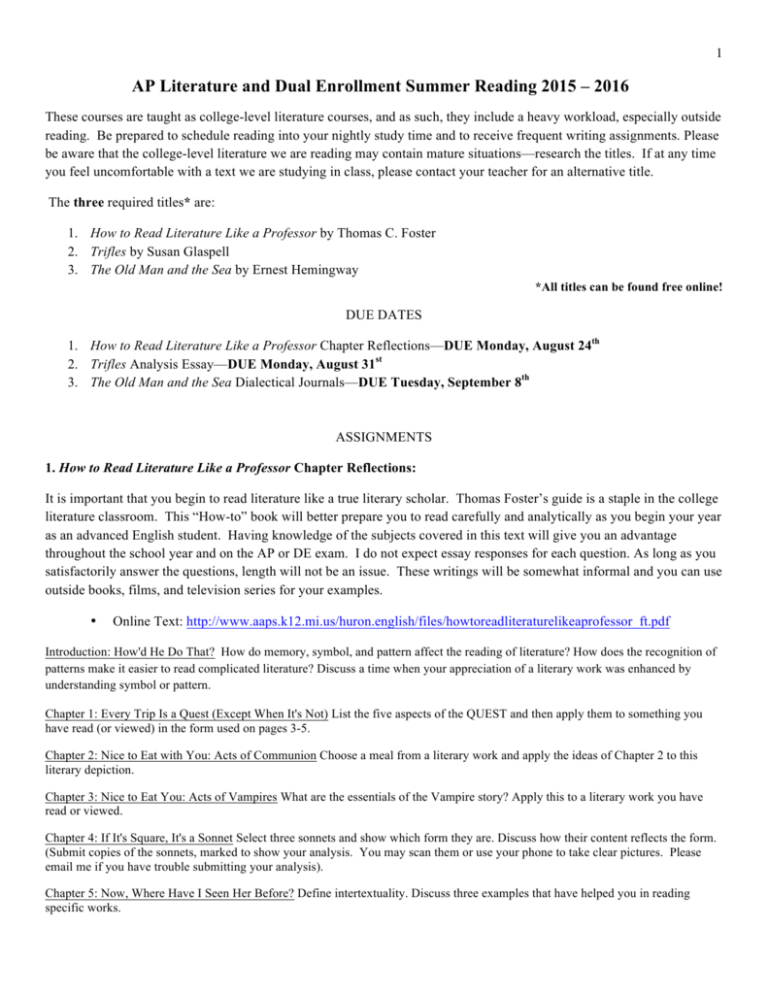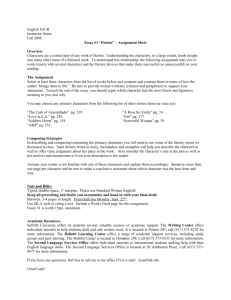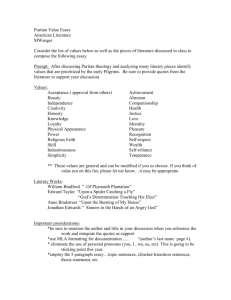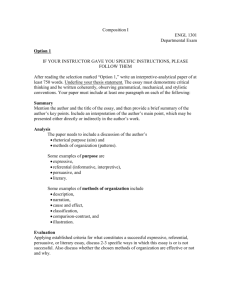AP Lit – Dual Enrollment Summer Reading
advertisement

1 AP Literature and Dual Enrollment Summer Reading 2015 – 2016 These courses are taught as college-level literature courses, and as such, they include a heavy workload, especially outside reading. Be prepared to schedule reading into your nightly study time and to receive frequent writing assignments. Please be aware that the college-level literature we are reading may contain mature situations—research the titles. If at any time you feel uncomfortable with a text we are studying in class, please contact your teacher for an alternative title. The three required titles* are: 1. How to Read Literature Like a Professor by Thomas C. Foster 2. Trifles by Susan Glaspell 3. The Old Man and the Sea by Ernest Hemingway *All titles can be found free online! DUE DATES 1. How to Read Literature Like a Professor Chapter Reflections—DUE Monday, August 24th 2. Trifles Analysis Essay—DUE Monday, August 31st 3. The Old Man and the Sea Dialectical Journals—DUE Tuesday, September 8th ASSIGNMENTS 1. How to Read Literature Like a Professor Chapter Reflections: It is important that you begin to read literature like a true literary scholar. Thomas Foster’s guide is a staple in the college literature classroom. This “How-to” book will better prepare you to read carefully and analytically as you begin your year as an advanced English student. Having knowledge of the subjects covered in this text will give you an advantage throughout the school year and on the AP or DE exam. I do not expect essay responses for each question. As long as you satisfactorily answer the questions, length will not be an issue. These writings will be somewhat informal and you can use outside books, films, and television series for your examples. • Online Text: http://www.aaps.k12.mi.us/huron.english/files/howtoreadliteraturelikeaprofessor_ft.pdf Introduction: How'd He Do That? How do memory, symbol, and pattern affect the reading of literature? How does the recognition of patterns make it easier to read complicated literature? Discuss a time when your appreciation of a literary work was enhanced by understanding symbol or pattern. Chapter 1: Every Trip Is a Quest (Except When It's Not) List the five aspects of the QUEST and then apply them to something you have read (or viewed) in the form used on pages 3-5. Chapter 2: Nice to Eat with You: Acts of Communion Choose a meal from a literary work and apply the ideas of Chapter 2 to this literary depiction. Chapter 3: Nice to Eat You: Acts of Vampires What are the essentials of the Vampire story? Apply this to a literary work you have read or viewed. Chapter 4: If It's Square, It's a Sonnet Select three sonnets and show which form they are. Discuss how their content reflects the form. (Submit copies of the sonnets, marked to show your analysis. You may scan them or use your phone to take clear pictures. Please email me if you have trouble submitting your analysis). Chapter 5: Now, Where Have I Seen Her Before? Define intertextuality. Discuss three examples that have helped you in reading specific works. 2 Chapter 6: When in Doubt, It's from Shakespeare... Discuss a work that you are familiar with that alludes to or reflects Shakespeare. Show how the author uses this connection thematically. Read pages 44-46 carefully. In these pages, Foster shows how Fugard reflects Shakespeare through both plot and theme. In your discussion, focus on theme. Chapter 7:...Or the Bible Read "Araby" (available online: http://www.gutenberg.org/files/2814/2814-h/2814-h.htm). Discuss Biblical allusions that Foster does not mention. Look at the example of the "two great jars." Be creative and imaginative in these connections. (The PDF file is also available on Edmodo if you would like a print copy.) Chapter 8: Hanseldee and Greteldum Think of a work of literature that reflects a fairy tale. Discuss the parallels. Does it create irony or deepen appreciation? Chapter 9: It's Greek to Me Write a free verse poem derived or inspired by characters or situations from Greek mythology. Be prepared to share your poem with the class. Be creative! Chapter 10: It's More Than Just Rain or Snow Discuss the importance of weather in a specific literary work, not in terms of plot. Interlude -- Does He Mean That Chapter 11:…More Than It's Gonna Hurt You: Concerning Violence Present examples of the two kinds of violence found in literature. Show how the effects are different. Chapter 12: Is That a Symbol? Use the process described on page 106 and investigate the symbolism of the fence in "Araby." (Mangan's sister stands behind it.) Chapter 13: It's All Political Assume that Foster is right and "it is all political." Use his criteria to show that one of the major works assigned to you as a freshman is political. Chapter 14: Yes, She's a Christ Figure, Too Apply the criteria on page 119 to a major character in a significant literary work. Try to choose a character that will have many matches. This is a particularly apt tool for analyzing film -- for example, Star Wars, Cool Hand Luke, Excalibur, Malcolm X, Braveheart, Spartacus, Gladiator and Ben-Hur. Chapter 15: Flights of Fancy Select a literary work in which flight signifies escape or freedom. Explain in detail. Chapter 16: It's All About Sex... and Chapter 17: ...Except the Sex (Optional Chapters) OK...the sex chapters. The key idea from this chapter is that "scenes in which sex is coded rather than explicit can work at multiple levels and sometimes be more intense that literal depictions" (141). In other words, sex is often suggested with much more art and effort than it is described, and, if the author is doing his job, it reflects and creates theme or character. Choose a novel or movie in which sex is suggested, but not described, and discuss how the relationship is suggested and how this implication affects the theme or develops characterization. Chapter 18: If She Comes Up, It's Baptism Think of a "baptism scene" from a significant literary work. How was the character different after the experience? Discuss. Chapter 19: Geography Matters… Discuss at least four different aspects of a specific literary work that Foster would classify under "geography." Chapter 20: ...So Does Season Find a poem that mentions a specific season. Then discuss how the poet uses the season in a meaningful, traditional, or unusual way. (Submit a copy of the poem with your analysis.) Interlude -- One Story Write your own definition for archetype. Then identify an archetypal story and apply it to a literary work with which you are familiar. Chapter 21: Marked for Greatness Figure out Harry Potter's scar. If you aren't familiar with Harry Potter, select another character with a physical imperfection and analyze its implications for characterization. Chapter 22: He's Blind for a Reason, You Know, Chapter 23: It's Never Just Heart Disease..., and Chapter 24:...And Rarely Just Illness Recall two characters who died of a disease in a literary work. Consider how these deaths reflect the "principles governing the use of disease in literature" (215-217). Discuss the effectiveness of the death as related to plot, theme, or symbolism. Chapter 25: Don't Read with Your Eyes After reading Chapter 25, choose a scene or episode from a novel, play or epic written before the twentieth century. Contrast how a reader from the twenty-first century could view it. Focus on specific assumptions that the author makes, assumptions that would not make it in this century. 3 Chapter 26: Is He Serious? And Other Ironies Select an ironic literary work and explain the nature of the irony in the work. Chapter 27: A Test Case Read “The Garden Party” by Katherine Mansfield, the short story starting on page 245. Complete the exercise on pages 265-266, following the directions exactly. Then, compare your writing with the three examples. How did you do? What does the essay that follows comparing Laura with Persephone add to your appreciation of Mansfield's story? Envoi Let me have it. What is your final opinion of this book? Did you have any meaningful insights or did it help you remember some of the great works you have read or viewed? Did you find any of the chapters especially interesting or unneeded? Be honest. 2. Trifles Analysis Essay: After reading Susan Glaspell’s Trifles, please answer the following essay prompt. This prompt was given on the 2000 AP Literature exam for the open essay question. Your response should be at least three pages typed in MLA format. (For MLA help, visit: http://owl.english. purdue.edu/owl/resource.) Make sure to use plenty of textual evidence to support your arguments. Please submit your essay before the deadline. If you use an eReader, like an iPad or a Kindle, this play can be read on the website below. You can also download the PDF of the play. It’s only ten pages long! Printing out the play will make it easier to take notes! • Online Text: http://www.wolaver.org/literature/trifles.pdf • Online Production: http://www.youtube.com/watch?v=f1LGwPFeSz8 Prompt: Many works of literature not readily identified with the mystery or detective story genre nonetheless involve the investigation of a mystery. In these works, the solution to the mystery may be less important than the knowledge gained in the process of its investigation. Choose a novel or play (You will be choosing Trifles!) in which one or more of the characters confront a mystery. Then write an essay in which you identify the mystery and explain how the investigation illuminates the meaning of the work as a whole. Do not merely summarize the plot. Warning: Any form of plagiarism will result in a 0 on the assignment and disciplinary repercussions. 9-Point Rubric for Essays An 8-9 essay responds to the prompt clearly, directly, and fully. This paper approaches the text analytically, supports a coherent thesis with evidence from the text, and explains how the evidence illustrates and reinforces its thesis. The essay employs subtlety in its use of the text and the writer’s style is fluent and flexible. It is also free of mechanical and grammatical errors. A 6-7 essay responds to the assignment clearly and directly but with less development than an 8-9 paper. It demonstrates a good understanding of the text and supports its thesis with appropriate textual evidence. While its approach is analytical, the analysis is less precise than in an 8-9 essay, and its use of the text is competent but not subtle. The writing in this paper is forceful and clear with few if any grammatical and mechanical errors. A 5 essay addresses the assigned topic intelligently but does not answer it fully and specifically. It is characterized by a good but general grasp of the text using the text to frame an apt response to the prompt. It may employ textual evidence sparingly or offer evidence without attaching it to the thesis. The essay is clear and organized but may be somewhat mechanical. The paper may also be marred by grammatical and mechanical errors. A 3-4 essay fails in some important way to fulfill the demands of the prompt. It may not address part of the assignment, fail to provide minimal textual support for its thesis, or base its analysis on a misreading of some part of the text. This essay may present one or more incisive insights among others of less value. The writing may be similarly uneven in development with lapses in organization, clarity, grammar, and mechanics. A 1-2 essay commonly combines two or more serious failures. It may not address the actual assignment; it may indicate a serious misreading of the text; it may not offer textual evidence or may use it in a way that suggests a failure to understand the text; it may be unclear, badly written, or unacceptably brief. The style of this paper is usually marked by egregious errors. Occasionally a paper in this range is smoothly written but devoid of content. Grade Conversion: 9 = A+ 8=A 7 = A- 6=B+ 5=B 4 = B- 3=C 2=D 1=F 4 3. The Old Man and the Sea Dialectical Journals For Ernest Hemingway’s The Old Man and the Sea, you are required to choose 10 important / meaningful / poignant quotations to analyze and discuss. Each quote should contain a 50 to 100-word reflection that demonstrates critical thinking about the characters, themes, tone, historical issues, social issues, or other relevant academic topics. Quotes should be pulled from the beginning, middle, and end of the story. • Online Text: https://la.utexas.edu/users/jmciver/Honors/Fiction%202013/Hemmingway_The%20Old%20Man%20and%20the %20Sea_1952.pdf The quotations should be word for word from the text and include both the chapter and page number. You can choose to do each quote on its own piece of paper or create a notebook-style format. If you choose to do the notebook, you can draw a vertical line down the middle of the page to clearly separate the quote from your analysis. This double-entry format option is below. • The left column would be titled Reading Notes (something direct from the text). • The right column would be titled Analysis and Questions (your own words, ideas, recognizable literary techniques, patterns, intertextuality, etc.). Sample Dialectical Journal for To Kill a Mockingbird by Harper Lee READING NOTES ANALYSIS AND QUESTIONS Quote/Passage (#) Response/Commentary “You never really understand a person until you consider things from his point of view . . . until you climb into his skin and walk around in it. (Chapter 3, pg. 34). This is a very famous quote and one that embodies the higher purpose of this novel. Though this quote occurs early in the novel, its message can be seen throughout. Atticus is fighting against social status; Boo Radley is fighting just to be seen as normal; and Tom Robinson is fighting just to be accepted despite the color of his skin. All of these people were sadly discriminated against because of the way they were – both by choice and by force – yet no one considered what they might be going through or how the world was from their perspective. If we all sit down and think about this idea, perhaps we can all learn something from their struggle, successes, and sad failures. Important Note: We will be studying this story in-depth in September. Your dialectical journals will be needed for class discussion and are crucial for your success on our first major assignments. We look forward to exploring many great works of literature throughout the year with you. Happy reading! J






